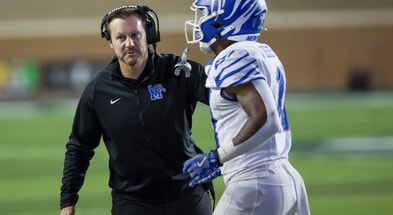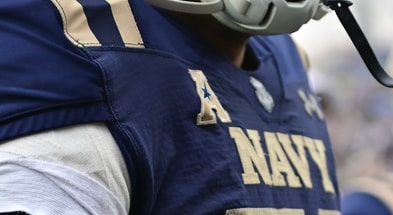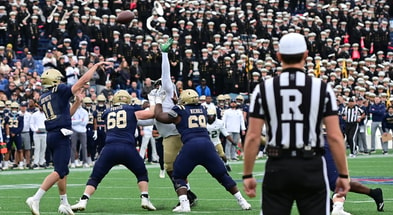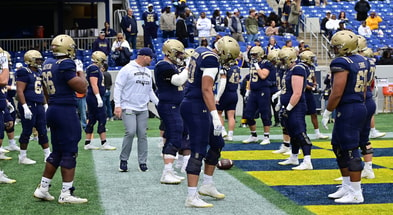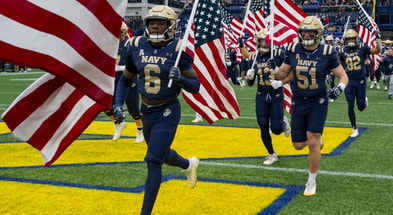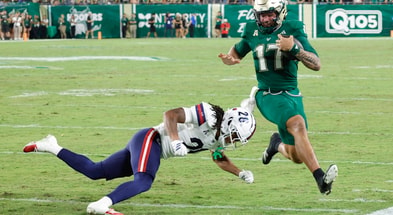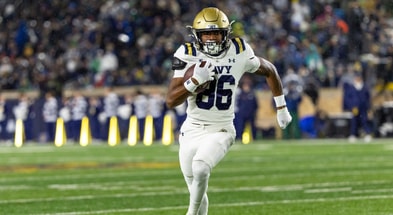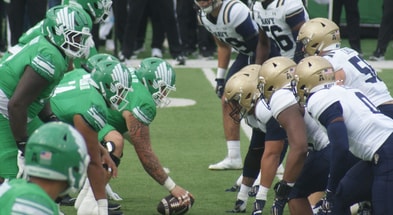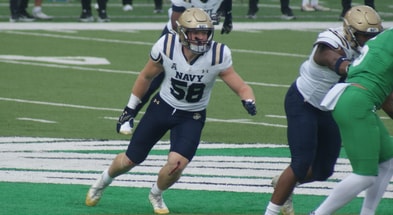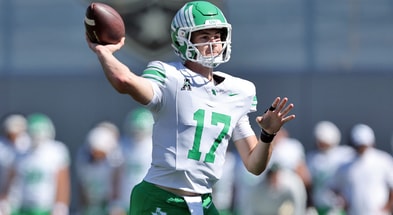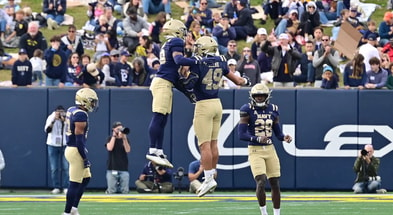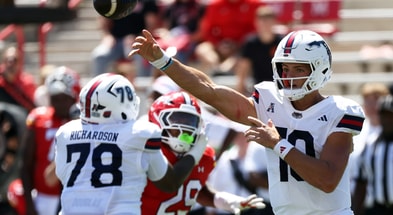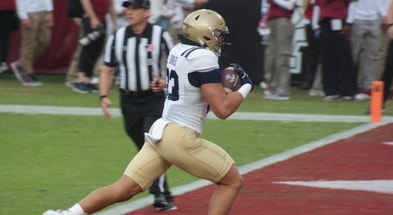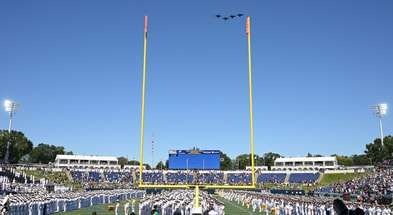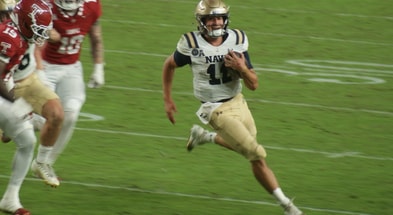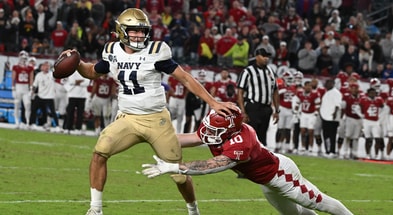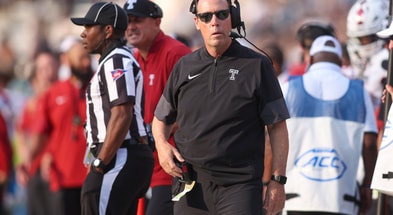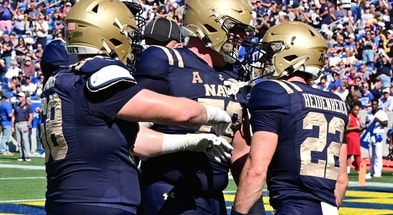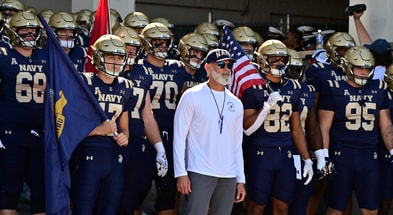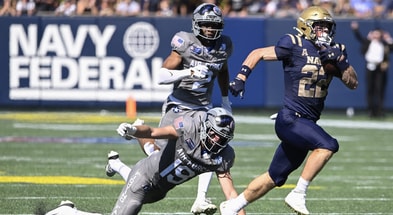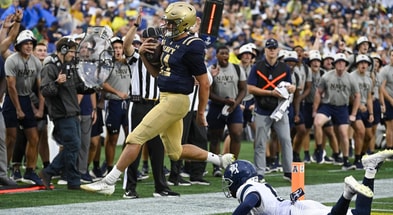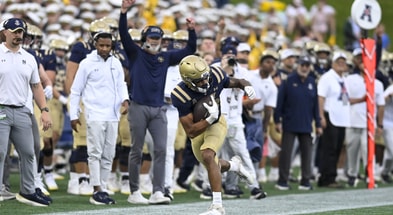The USF Debrief
Long before the season started, Navy fans had November circled on their calendars. This was when the schedule got real; when the Mids would run the gauntlet of conference contenders. But the team had eyes on the conference championship themselves, and they would need to win games like these to prove they belonged.
On Saturday, they did. Navy took down #24 USF, 41-38, in front of a sold-out crowd in Annapolis. Eli Heidenreich became the program’s all-time leader in career receiving yards after catching five passes for 146 yards. Alex Tecza added 126 yards and a touchdown on the ground, while Braxton Woodson had 103 yards and two more TDs in relief of a cramping Blake Horvath. Defensively, Coleman Cauley and MarcAnthony Parker combined for 21 tackles, while Phillip Hamilton was named American Conference Defensive Player of the Week after notching seven tackles, an interception, and a forced fumble. The win moved Navy to 8-2 on the year and kept them alive in the race to make the conference championship game.
What a game.
Brian Newberry talks all the time about complementary football, and there might not be a better example than what we saw here. Navy’s defense made early stops that allowed the offense to build a cushion. They continued to make stops when the offense hit a lull in the middle third of the game. When the defense started to falter, the offense picked things back up to keep the Bulls at arm’s length on the scoreboard. Then, when the offense got the ball at the end of the game, they picked up the first down they needed to close it out. Throughout all of it, Navy’s special teams shone. Kickoff coverage was excellent, to the point that USF eventually started fair catching every kickoff because the 25-yard line was better than what they had been running for. Nathan Kirkwood hit two big field goals, including a 44-yarder. Jacob Carlson averaged more than 46 yards over his four punts and had two downed inside the 10-yard line.
In a three-point game, all of it mattered. This was a complete team performance.
You could tell early on that this was going to be a whale of a game. Physically, USF is a bunch of monsters. I’ve been on the field for every game to see the visiting team get off the bus, and USF set a new standard for the look test, as you’d expect for one of the American Conference’s NIL kings. Early in the contest, they made a point to emphasize their brute strength. Every hit looked like it was delivered with a Tyson-like intent, looking to end the contest in the first round. But Navy answered back in kind, setting the tone for a physical game that I’m not sure the Bulls expected.
In the preview, I outlined a few things I expected to see in the game and key points for the Mids. USF’s defense is very aggressive, and after using an eight-man front in last year’s matchup, I counted on them doing the same thing this year. If that was the case, Navy had to find a way to make them pay for that aggression. The explosive plays that had been missing over the previous two games had to make a return. And with a single safety in the defensive backfield, Heidenreich needed to make an impact as a receiver.
We got all of that and more. USF did indeed use an eight-man front with a single deep safety. Navy got their explosive plays, with passes of 82 and 32 yards along with touchdown runs of 76, 20, and 64 yards. Heidenreich had his second-best receiving day of the season, and Navy’s 186 passing yards were the most from the team since the Air Force game.
From an Xs and Os perspective, this was an interesting game for the Navy offense. It’s almost like they played two different plans: one under center, and one in the shotgun. Not that they don’t line up both ways in every game, because they obviously do. But in this case, they were both designed to take advantage of different tendencies from USF. It might be hard to convince anyone of this after they allowed 524 yards, but USF’s defense was very good. They were aggressive and disciplined at the same time, which can be challenging to pull off. But they did it.
We mentioned in the preview that USF defensive coordinator Todd Orlando is one of the better coaches Navy has faced at understanding option offense mechanics. In his recent matchups against the Mids, he has alternated between the squeeze-and-scrape stunt and the EZ stunt (1-2 exchange). Neither one “solves” the triple option, but by switching between them, he made his defense hard to predict. The offense can’t lean on its usual answers for these stunts because it wasn’t sure which one would be run next; what works against one wouldn’t work against the other.
So for Navy, the offense came down to compartmentalizing three different aspects of USF’s defense. They had to use USF’s aggressiveness against them. They had to figure out how to leverage USF’s discipline against them. And finally, they had to figure out how to handle a defense that used different stunts from play to play.
We’ll start with the last one. In Tampa last year, the Mids turned to the power game, taking away any need to guess about what stunt they’d be facing. They did much of the same this year, often running off tackle, albeit with limited success. But they also added the QB follow play. While it seems counterintuitive to run this against an 8-man front, it actually makes sense. The play hits quickly enough that you’re really just boiling the entire defense down to two defensive linemen and two linebackers on the play side. When you run to the tight end side, you should have five playside blockers to four defenders. It worked reasonably well.
You’ll notice that they had a couple of different variations of that play: one with the fullback running inside, and the other with the fullback blocking the defensive end outside the QB’s path. The inside linebacker reads the fullback on that play, with the idea that fitting the lead blocker would lead to the ball carrier. Neither variant was overly successful, but it helped to set up the midline option. When the ILB took the fullback, the quarterback had a giant hole to run through.
The Mids also tried to find ways to run the triple option despite the changing stunts. They tried to get a numbers advantage using a two-for-one block, and it worked the first time; the tight end blocked the inside linebacker, and the pitch key followed him. The cornerback did fairly well reading the play and not following the split end all the way to the safety, but he was still just one player trying to defend two potential ball carriers. The second time the offense attempted it, though, the inside linebacker scraped outside. The ILB wasn’t the pitch key here, so when Horvath pitched off of him, the cornerback was in a much better position to make the stop.
The offense had more success running the triple option a different way. After lining up a snipe behind the tackle like usual, they sent him in motion outside. If the outside linebacker followed him, the offense knew that he wasn’t going to stunt inside to take the fullback. Instead of pitching off of him, the snipe blocked him. That made the scraping inside linebacker the pitch key.
Navy’s answer for USF’s aggression was Heidenreich. With the Bulls spending most of the game with only one deep safety, the Mids had to connect through the air. As usual, the Z-snipe was the primary beneficiary. He often found himself matched up against the safety, and that was when he had his most significant impact.
When the safety started cheating forward, Heidenreich got behind him:
When the safety stayed back, he cut in front of him:
Later in the game, USF tried bringing the safety up in run support and having a backside defender rotate back to cover the deep middle:
When that happened, Heidenreich ran a corner route, cutting outside well before the rotating DB could reach him.
Because USF only had one safety and was being aggressive with him, they didn’t want to risk using press coverage. So when Heidenreich was doubled, Josh Guerin was open on a comeback route.
Alex Tecza’s touchdown reception was set up by a jet sweep that was run two plays earlier. He was a lead blocker on that play, and on the pass, he tracked like he was going to block again before cutting upfield. The linebacker covering him tried to get a jump on the sweep, and Tecza ran right by him.
Finally, the Mids had to figure out how to move the ball against USF’s discipline. The Bulls were very well-coached on an individual level, which made it difficult to get them running the wrong way. But offensive coordinator Drew Cronic found ways to use that to his advantage.
Navy’s first touchdown was on a counter trey option, with the guard and tackle pulling one way and the quarterback having the option to keep and run the other way. The backside linebacker was prepared for this and stayed home to play the possibility of a backdoor run. But by staying home, he gave the playside tackle enough time to reach him after helping with the defensive tackle. That was the key block on the play to spring Tecza after the other linebackers did their job by following the pulling linemen.
The same thing happened later in the half on a similar play, only with a center-tackle pull instead.
After Horvath left the game, the defense seemed to key more on Tecza and Heidenreich.
That caused them to lose some of their discipline on the back side and set up what ultimately became the game-winner. While Tecza and Heidenreich faked a sweep one way, Braxton Woodson ran a counter to the backside, and nobody was there to stop him.
It seems so simple while watching these clips, but the reality is anything but. For every explosive play you see here, there were a lot more one- or two-yard gains to set them up. Navy’s average third-down distance to go was eight yards. Their passing down percentage– defined as second down with 8+ yards to go and third or fourth downs with 5+ yards to go– was 40%. Navy needed explosive plays because USF wasn’t going to let them drive the length of the field. The Mids’ touchdown drives averaged 4.8 plays. Their only drive of more than 9 plays resulted in a punt.
Defensively, it feels like this is what the North Texas game should have been. The Mids had a similarly light box against the run, which may have contributed to USF’s decision to keep giving the ball to the running backs up the middle. But Navy’s defensive line consistently got into the backfield, with Cauley and Parker reaping the rewards. The Bulls were much more effective in the second half, but by then, they were playing catch-up. With the Navy offense ripping off big plays of its own, USF couldn’t close the gap.
This is what November football is supposed to be about: two heavyweights unloading haymakers, with one left standing in the end. Navy wasn’t perfect by any stretch, but they played their best game of the season and took down the conference favorite. In the process, they returned to their winning ways and kept themselves alive in the conference race. There’s a long way to go, and the Mids need help, but every goal is still on the table. As we head into Thanksgiving, you can’t ask for much more than that.
